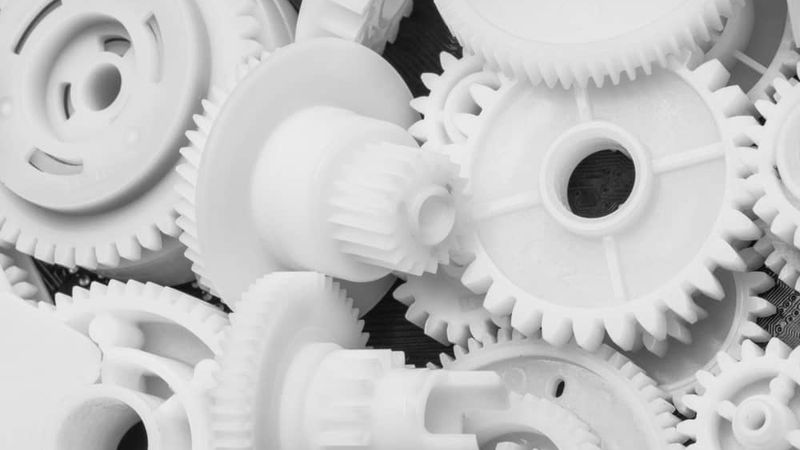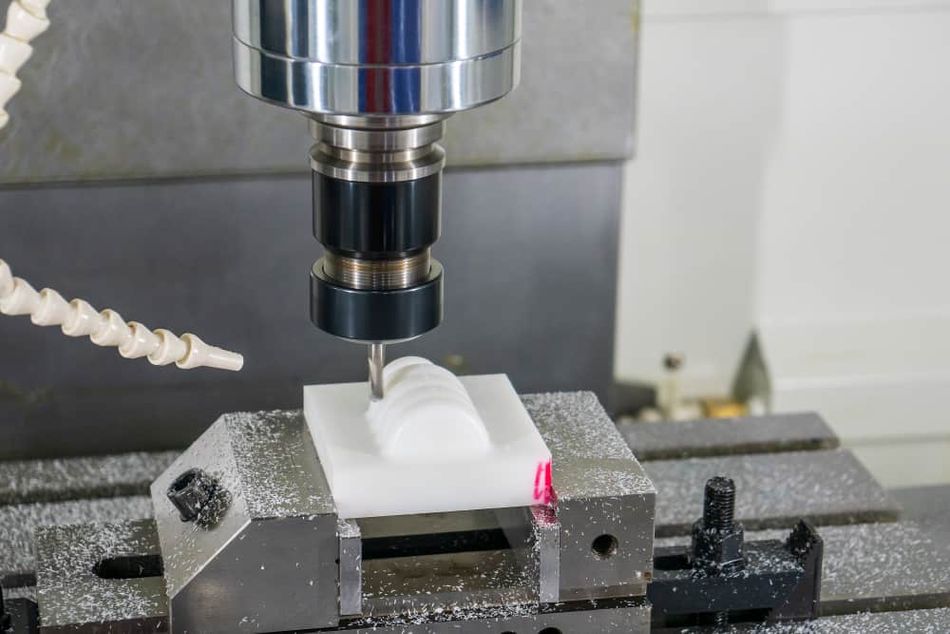Delrin material properties, applications, and more
Here’s what you need to know about Delrin, a high-performance POM thermoplastic with exceptional strength, durability, and temperature resistance.

Delrin is the DuPont brand name for POM, an acetal homopolymer
A material that goes by many names, Delrin is a ubiquitous plastic used for a wide variety of products across many industries, from automotive and healthcare, to consumer and electronics. The material is particularly common for mechanical parts, such as gears, fittings, and bearings, due to its excellent strength and durability, as well as outdoor applications, thanks to its water resistance and thermal properties.
In this article, we’ll dive further into the material that is Delrin, looking at its origins, composition, and material properties, as well as explain how it is manufactured and used for different applications.
What is Delrin?
Delrin is the brand name for polyoxymethylene (POM), an engineering-grade thermoplastic with a variety of applications. The plastic material is also commonly known as acetal, polyacetal, or polytrioxane. [1]
The polymer POM was first discovered in the 1920s by German chemist Hermann Staudinger and physicist Gustav Mie, proving to be a game-changing revelation in the world of materials and plastics. Despite the big discovery, however, POM was not commercialized for several decades. [2] It was chemical giant DuPont that succeeded in this mission: first synthesizing the thermoplastic in the early 1950s, patenting the material in 1956, and then starting to mass produce it under the Delrin brand name in 1960. [1]
In general, Delrin is known for its excellent strength, dimensional stability, temperature resistance, and low friction. This combination of properties, along with good processability have made it a popular option for injection molding, machining, and (more recently) 3D printing. The polymer is broadly used across many industries and has found a particular niche as a metal replacement thanks to its good strength-to-weight ratio, wear resistance, and tensile strength.
From a chemical standpoint, Delrin has a chemical formula of (CH2O)n. It is an acetal homopolymer, meaning it contains only one type of monomer, units of which are connected by chemical bonds. Notably, Delrin is described by DuPont as “one of the most crystalline engineering thermoplastics available,” which imparts superior mechanical properties. [3]
What are Delrin material properties?
In the briefest of terms, Delrin is known for its excellent mechanical and thermal properties, as well as good chemical resistance, low moisture absorption, and electrical insulation. Compared to acetal copolymers, the acetal homopolymer displays a number of superior properties, including better tensile strength, fatigue endurance, impact strength, creep resistance, and stiffness. According to DuPont, these properties unlock opportunities for “thinner, lighter-weight parts” as well as for metal replacement applications that require excellent resistance and durability. [4] Let’s take a closer look at the properties of Delrin, starting with mechanical properties.
Delrin mechanical properties
Delrin has a high tensile strength of 10,000 psi at room temperature with no yield point.
It also has high stiffness, with a 410,000 psi stiff flexural modulus.
Delrin’s elongation at break is 10 to 40%.
The material displays high fatigue resistance, withstanding cyclic compressive and tensile stressing of 5,000 psi.
Low friction is also a key property. Delrin’s coefficient of friction against steel is 0.1-0.3. The material’s low friction is highly consistent regardless of thermal conditions, loads, and other factors.
Excellent creep resistance, impact resistance, and abrasion resistance.
Delrin has low water absorption and is thus suitable for humid or wet environments.
Delrin thermal properties
Delrin has good temperature resistance, with an operating range of -40 °C to 90 °C.
At elevated temperatures of up to 90 °C, Delrin maintains its high strength and exhibits a tensile strength of 2,000 psi and flexural modulus of 180,000.
Delrin only loses 20% of its impact resistance at extreme cold temperatures of -40 °C compared to room temperature. [5]
Delrin does not succumb to significant brittleness increases at cold temperatures.
In water, Delrin can safely withstand temperatures of up to 65 °C without performance compromises.
Delrin chemical properties
Delrin displays strong resistance to organic solvents and neutral chemicals.
The material’s chemical resistance is strongest at temperatures below 70 °C.
Delrin is also highly resistant to discoloration.
Certain newer grades of Delrin have improved UV resistance.
Delrin electrical properties
Delrin is an excellent insulator and maintains good dielectric properties across a wide temperature range, as well as in moist or wet conditions.
Delrin has low dissipation factors, making it a highly efficient insulating material.
Delrin is flammable, with a UL94 flammability rating of HB (horizontal burning).
How to manufacture Delrin products?
Most products made from Delrin are produced using injection molding or machining. Below are some best practices for each production method.
Injection molding Delrin
Injection molding is a well established manufacturing process used to mass produce parts. The process consists of melting thermoplastic pellets and injecting the melted material into a mold. The process is performed under pressure to ensure that the mold is properly filled. Once the mold has been injected, the plastic rapidly cools resulting in a solid product. Injection molding is known for producing high tolerance parts with high quality surface finishes. High repeatability and cost per unit for large production volumes are two other benefits of the production process.
DuPont’s Delrin resins are highly suitable for injection molding and are compatible with conventional molding machines and standard practices. There are, however, some specific settings and practices that ensure injection molded parts are of the highest quality. When injection molding Delrin, the lowest back pressure should be maintained, while hold pressure should be set between a range of 60 to 110 MPa depending on the Delrin grade used.
In terms of temperatures, Delrin requires a temperature of 215±5 °C (the material’s melting point is 175 °C), though some tougher Delrin grades require a lower temperature of 205±5 °C. The mold temperature for standard Delrin should be kept within the range of 80 to 100 °C, though higher precision parts can benefit from higher mold temperatures of up to 120 °C. Drying is only required in certain circumstances when injection molding Delrin, including if moisture content exceeds 0.2% or if the material has not been properly stored. [6]
Recommended reading: Tips to reduce injection molding costs
CNC machining Delrin
CNC machining is a high-precision subtractive production method that uses cutting and milling tools to remove material from a blank based on a CAD model. CNC machining is commonly used in the manufacture of custom parts or small to medium-sized production runs. Both metals and various polymers, including Delrin, can be machined, resulting in high-quality parts with tight tolerances.
Delrin is a highly machinable thermoplastic with good dimensional stability. This means parts can be made with tight tolerances of +/-0.005 and without significant risk of deformation during the machining process. As a thermoplastic, Delrin does eventually start to soften and melt when heated well above 90 °C, so it’s important to use a cooling method throughout the machining process. Air-based coolants are the best option when machining Delrin and help to achieve superior surface finishes.
Another thing to note when machining Delrin is that the manufacturer should use dedicated tools: using the same tools for metals or other plastics and Delrin can lead to contamination and production issues. A slow feed rate and fast cutting speed are recognized as the optimal combination for machining Delrin. In general, the material is one of the best thermoplastics for machining. [7]
Recommended reading: 5 design guidelines for common machining parts
Can you 3D print Delrin?
While injection molding and machining are the dominant manufacturing methods used to make Delrin parts, the thermoplastic material can also be 3D printed. When talking about 3D printing, it’s perhaps a bit more helpful to discuss POM filaments, Delrin being a brand name. There are a number of POM-based filaments suitable for FDM 3D printing, including Gizmo Dorks Acetal filament and a HobbyKing POM filament. It’s admittedly not one of the most common 3D printing materials, and it does present certain challenges. For that reason, there are a greater number of POM copolymer (as opposed to homopolymer acetal) filaments, which have been engineered for better printability.
When 3D printing POM, there are certain best practices that should be followed. For starters, POM requires a heated build plate to ensure good first layer adhesion. Gizmo Dorks recommends a heated bed plate between 100 °C and 130 °C. Even then, adhesion can be tricky, so using an additional build plate surface, such as a cellulose platform or even a wood-based platform, can help increase grip. Tape and other adhesive surfaces can also be used to improve adhesion.
POM requires a printing temperature between 210 and 220 °C, and parts can benefit from a heated print chamber. This helps to improve inter-layer bonding and reduces the risk of warping. It is also important to 3D print POM in a well-ventilated area and to keep the printing temperature below 230 °C to avoid any formaldehyde emissions, which are dangerous to inhale. [8]
Recommended reading: The most popular 3D printing materials in FDM and their properties
Industrial applications for Delrin plastic
The unique combination of Delrin’s properties have made the material a go-to option for a variety of applications. In particular, the material’s strength and durability are ideal for the production of mechanical parts. Manufacturers supply Delrin components to multiple industries, including automotive, aerospace, consumer, electrical, food services, healthcare, and industrial.
Common mechanical applications for Delrin include gears, screws, bushings, bearings, conveyor belts, fittings, door systems, and more. The material is also used in the production of safety restraints thanks to its durability and tensile strength. Its excellent dielectric constant also has benefits for the production of electrical enclosures, connectors, and other insulating electrical parts. Furthermore, the material’s resistance to moisture is perfect for parts that are exposed to humidity and water, such as kitchen appliances.
In the medical sphere, Delrin is used for many applications, including metered dose inhalers, auto-injector pens, tubing clamps, and various other medical instruments. Delrin’s rigidity and ability to be sterilized using autoclave are behind its adoption in the highly stringent field. [9] There are also FDA certified grades of Delrin which are suitable for use in the food industry. In fact, a number of DuPont’s POM-H resin grades have been certified for potable water and food contact and are in use for applications including food packaging, filtration parts, food processing systems, tanks, and more.
Key takeaways
Delrin is the DuPont brand name for polyoxymethylene (POM), an acetal homopolymer thermoplastic.
The material has various applications across the automotive, medical, electrical, consumer, and industrial sectors.
Delrin is known for its low friction, low moisture absorption, high strength, dimensional stability, and thermal resistance.
Delrin can operate at temperatures in the range of -40 °C to 90 °C.
The engineering thermoplastic is most often injection molded or CNC machined. 3D printing is possible, but presents certain challenges, such as adhesion.
Common applications for Delrin are gears, screws, bearings, electrical enclosures, medical devices, food packaging, and more.
References
[1] https://www.chemeurope.com/en/encyclopedia/Polyoxymethylene.html
[2] https://www.ptonline.com/articles/tracing-the-history-of-polymeric-materials-part-8
[3] https://www.dupont.com/knowledge/whitepaper-delrin-advantages.html
[4] https://www.dupont.com/delrin.html
[5] https://www.piedmontplastics.com/blog/delrin-plastic-sheet
[7] https://waykenrm.com/blogs/a-basic-guide-about-machining-in-delrin/
[8] https://gizmodorks.com/acetal-3d-printer-filament/
[9] https://www.distrupol.com/delrin-medical.html


